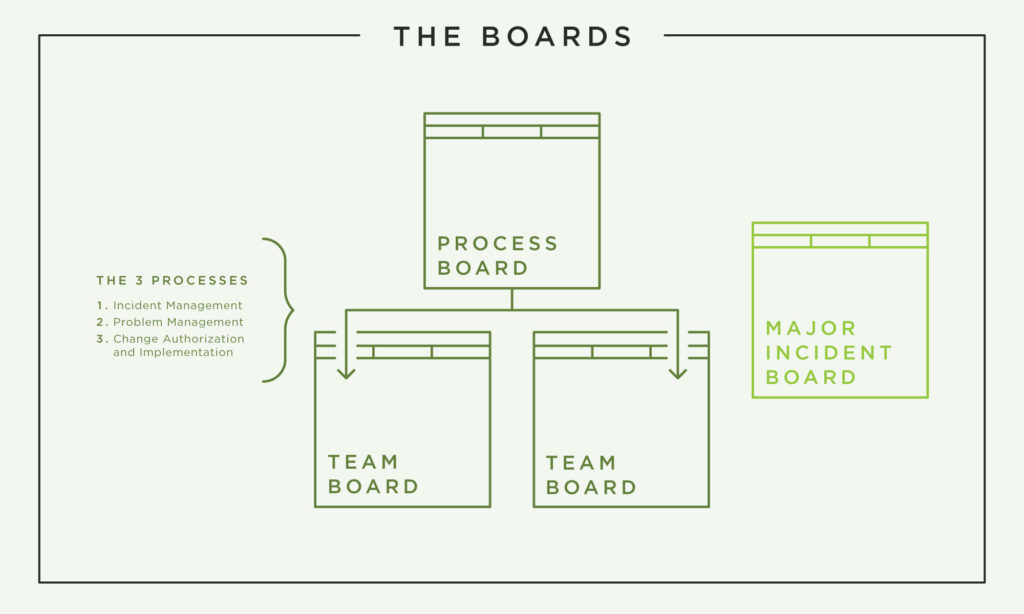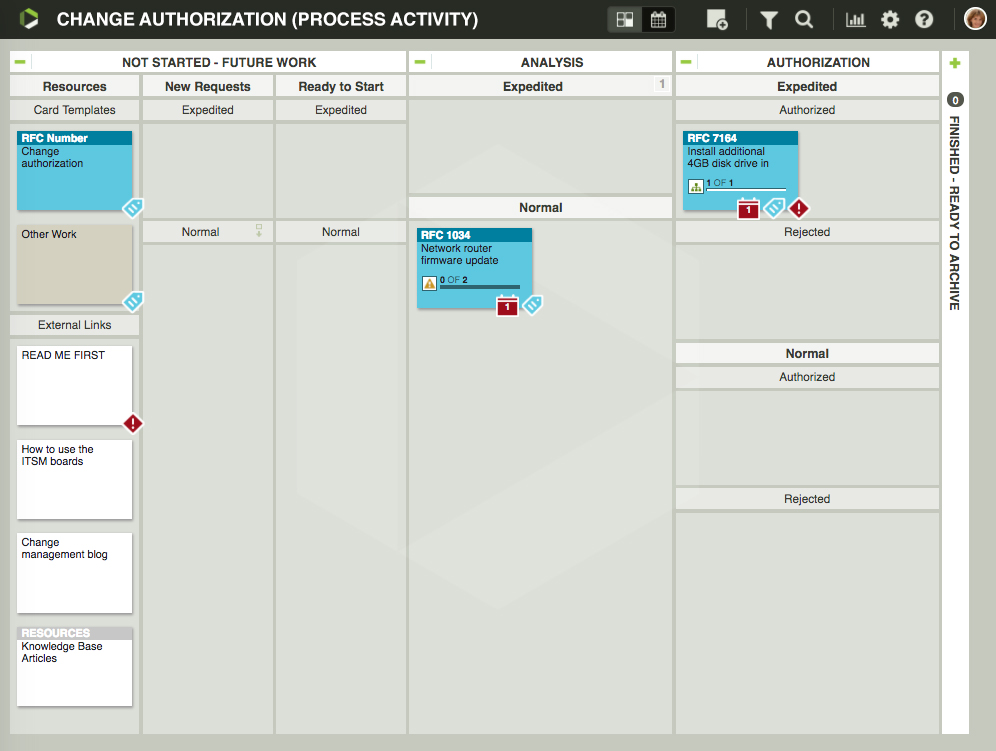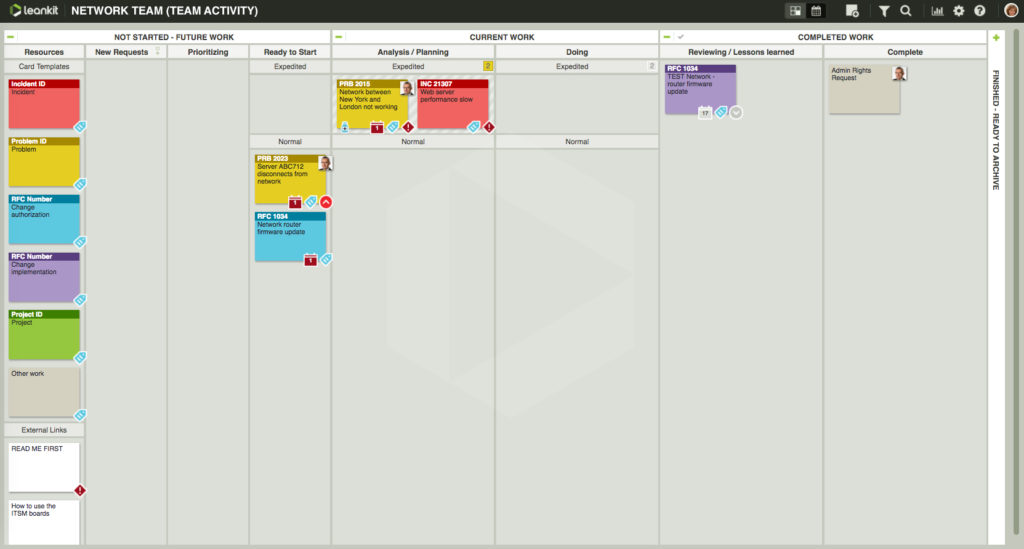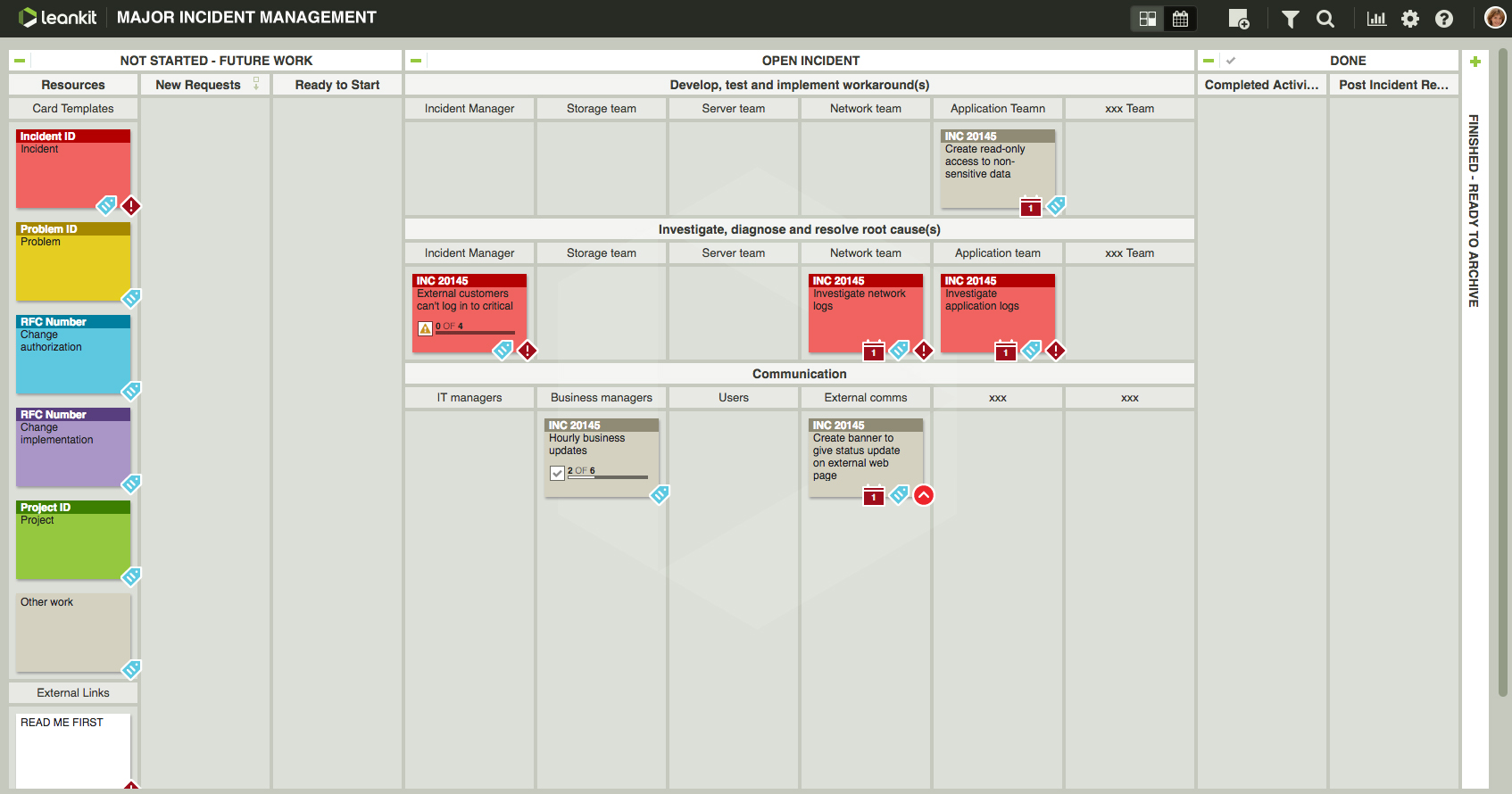
When multiple teams, various tools, and stakeholders from across the business are involved, IT Service Management (ITSM) processes can be complicated and challenging to manage — but Kanban can help. We’ve created new board templates, based on ITIL guidelines, to quickly get started on managing and implementing your ITSM processes. These new Kanban board templates will give your team the visibility it needs to take a systems-thinking approach to prioritizing and managing problems, changes, and incidents — resulting in faster time to resolution and reduced costs.
Keep reading to learn how your team can use these Kanban board templates, with specific examples of some of your most common workflows: incident resolution, problem and incident management, change authorization, and change implementation.
ITSM Board Templates
Our new Kanban board templates are designed to give the right level of visibility to everyone involved in your ITSM processes — from teams to managers to executives.
These templates can be used together, or as standalone boards, to get the clarity and alignment you need across your IT organization. Using these templates together can present a powerful way to manage changes, problems and incidents. For complex or enterprise scale scenarios, one overarching board can be used to manage and track all assigned activities associated with each process, while team-level boards facilitate the work required to complete each activity and automates progress reporting.
If you prefer a consolidated/combined view of the process and the team activity, we also have templates that visualize it all in one place. And don’t forget that these are templates — a place to get started. The templates were designed for maximum flexibility, so you can customize them based on your organization’s specific needs. They were also designed to nurture an environment for learning and process improvement, with built-in review steps included in each process.
Why ITSM Needs Kanban
Ask any IT Service Manager to name his or her biggest challenge and you’re likely to hear: “My team members have work they’re completing under-the-radar, so I don’t know the true extent of what my teams are working on,” or “So much work is dropped on us unexpectedly that I can’t plan or prioritize properly.”
Kanban boards give organizations implementing ITSM the ability to visualize any ITIL-based process, including the hidden and unplanned work. Seeing the the entire value stream in a single view ensures that processes are followed consistently across the organization and removes handoff friction between the various teams required to complete the work.
It also enables continuous service improvement as teams can see where process waste – such as bottlenecks or wait time – is impeding flow and work together more effectively to speed up delivery.
Using these Kanban board templates makes it easier for teams to collaborate, communicate more effectively with each other and their stakeholders, and deliver resolutions faster. It will also provide managers with the birds’ eye view they need to effectively manage ITSM processes, giving them the visibility they need to understand the impact unplanned work has on their team so they can set realistic priorities and manage reasonable expectations for better business outcomes.
About the Board Templates
These Kanban board templates are designed to help you effectively manage and improve key ITSM processes, including change, problem, and incident management — as well as provide an on-the-fly solution for coordinating major incidents as they arise.

Scenario 1: Change, Incident, and Problem Management
ITSM teams manage processes for business-critical changes, problems, and incidents that impact the entire organization. Effective communication is critical during each of these processes: Stakeholders need to stay informed of deployment and resolution progress, while teams working through each of these processes need task-level visibility to understand the context of their work.
This is why we’ve created several Kanban board templates, to satisfy the information and process needs of these different groups. Use these Process Activity boards to visualize change, incident, and problem management at the organizational level.

Then, delegate tasks to the Team Activity boards of the teams doing the work. This will provide stakeholders with the status reporting they need, while allowing teams to manage and prioritize the work against their existing workflow.

Here is a brief description of each of our new board templates:
- Change Authorization (Process Activity): The goal of change management processes is to ensure that standardized methods and procedures are used for efficient and prompt handling of all changes. This minimizes the impact of change-related incidents upon service quality, and consequently improves the day-to-day operations of the organization. Use this board template to manage any change authorization requests.
- Change Implementation (Process Activity): After a change has been authorized, it must be deployed. Use this board template to manage change deployments, keep all teams informed and aligned, and help teams deliver high-quality changes faster.
- Incident Management (Process Activity): Although major incidents may need immediate and singular attention, deserving unique boards, other incidents may be routine, not requiring a disruption of regular activity. Use the ITSM incident management process template to prioritize incidents based on impact to the business.
- Problem Management (Process Activity): Teams use ITSM problem management processes to diagnose the root cause of incidents identified through the incident management process. They also use this process to determine the resolution to those problems. Use the Problem Management board template to ensure that each resolution is implemented through appropriate control procedures, especially change management and release management.
Using the ITSM Kanban Board Templates
At the Process Activity board level, managers create cards to represent each new change, incident, or problem that needs resolution or deployment. Each of these items can be prioritized and tracked on their respective boards, so Process Activity boards are great for stakeholders to watch for progress and status updates.
Each one of these items, whether it is a change, incident, or problem, is typically comprised of several work items that may span teams. The network team might take on some work, while the server team may take on a different work item required to resolve or deploy the work at stake.
These teams need the context of the larger picture to ensure they have accurate and up-to-date information that will lead to quicker, more reliable work. The high-level changes, incidents, and problems on the Process Activity boards can be connected easily to work items on individual Team Activity boards. They can updated in real time as connected work items move across team boards.
Teams who do not currently connect cards across multiple boards can follow the same process, but consolidate the lanes and cards onto one board that all involved parties have access to. These teams should use the Process & Team Activity group of templates to get started.
Scenario 2: Major Incident Resolution

The ITIL major incident management process is designed to ensure that normal service operation is restored as quickly as possible, that business impact is minimized.
Let’s take the example of a business-critical application becoming unavailable. In this situation, multiple activities happen simultaneously, such as devising workarounds, getting authorization to do a failover, investigating root causes, and communicating with stakeholders. Without a tool to manage incidents and keep the entire team on the same page, incidents can often turn into chaos, as team members rely on email threads and outdated spreadsheets and accurate, updated information can be difficult to track down.
With the Major Incident Management board templates in Planview AgilePlace, teams can use a single Kanban board per incident. This short-term board is visible to all stakeholders, immediately improving collaboration and communication between teams.
This Kanban board also provides a focal point for swarming and ensures that timely, accurate information is provided to stakeholders at all levels of the organization. And with mobile device access to incident boards, stakeholders receive real-time updates for business-critical incidents anywhere and anytime.
Because of the nature of incidents, incident response boards are typically created on the fly and typically have a lifespan that’s shorter than other ITSM board types. Using a board template that’s designed for incident response can help teams immediately create a temporary, focused workspace and get right to work. Teams can manage and track all activity related to each incident in a meaningful way, and compare their performance against past incidents. This enables better communication, and helps facilitate learning and process improvement across the IT organization.
Kanban for IT Operations
These Kanban board templates are intended to help IT Operations teams manage their work. IT Operations teams are responsible for managing incidents and problems, as well as authorizing and implementing changes and contributing to projects; in order to effectively balance those multiple sources of demand, they need to be able to visualize it effectively. Using these templates will help IT Operations teams proactively manage their work, so that they can reach the level of sustainability and predictability desired by the organization.
Managers of these processes, such as incident managers, problem managers or change managers, will also find these templates helpful.
These templates are available for Planview AgilePlace customers using our Select, Advanced, and Enterprise editions.
![A Global Collaborative Work Management Blueprint [Video]](https://blog.planview.com/wp-content/uploads/2019/07/A-Global-Collaborative-Work-management-blueprint.png)



